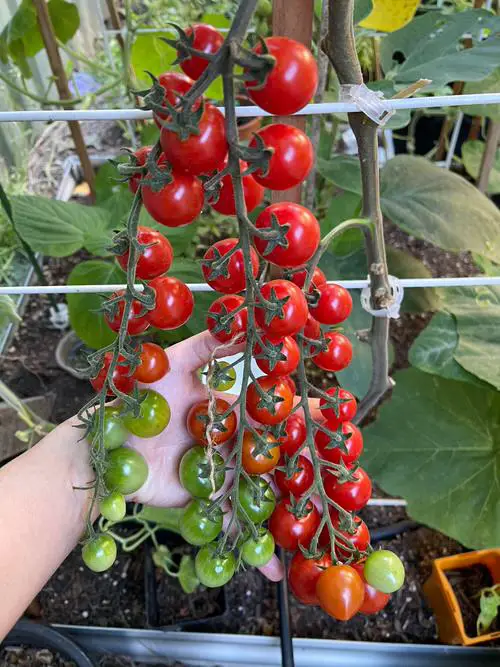Discover the 4 best ways to grow sweeter tomatoes. Applying these tips will also make your homegrown tomato harvest more delicious!

Homegrown tomatoes taste heavenly when they are sweet with a hint of tart, acidic flavor. If you want to grow the same, there is a science behind it. And what is it, find out below!
Number One Technique to Produce Sweeter Tomatoes

Phosphorus is the Key Element that Directly Results in Sweeter Tomatoes!
Fertilization, in a proper ratio, plays a crucial role in making tomatoes sweeter. According to research, fertilization with a higher phosphorus ratio has a significant effect on quality, color, sweetness, and taste of tomatoes.
According to this article published on the University of Missouri website, phosphorus, and potassium have favorable effects on fruit acid and sugar content. “The number one secret to growing sweeter tomatoes is having more phosphorus in the soil.”
Another study indicates that increasing the rate of potassium in the growing medium while cultivating tomatoes results in tissue redness, firmness, crispness, and more acidic flavor.
Remember that tomato variety, degree of ripeness, and proper sunlight exposure in the right proportion also play a vital role in producing flavorful and sweet tomatoes.
Using a fertilizer that is high in phosphorus can give you sweeter tomatoes!
Check out our article for a bumper tomato harvest here
Why Tomato Plants Require Phosphorus?
Phosphorus is necessary for the overall plant growth, formation of blooms, and flowers. It assists in building cell membranes and storing energy. The tomatoes’ sweetness, size, and color depend primarily on the phosphorus content in the growing medium.
Effects of Phosphorus Deficiency on Tomatoes
- Stunted or spindly growth.
- Flower and buds drop or unripe fruit.
- More petite and bitter tomatoes.
Natural Sources of Phosphorus for Tomatoes

Instead of applying inorganic, commercial fertilizers, it’s best to try these natural sources for sweeter and better tomatoes. Because using too many commercial fertilizers rich in phosphorus may also toxify your soil.
- Bone Meal: It is an excellent source of phosphorus (18-24%) and nitrogen (0.7-7%). This is what you should use for sweeter tomatoes.
- Neem Cake: Add 2-4 tablespoons of neem cake to the tomato at the time of planting as it is rich in phosphorus, nitrogen, and potassium. It also keeps the plant free from pests and fungal attacks while making sure it blooms for long.
- Banana Peel Fertilizer: It is another great source of phosphorus and results in healthy growth with sweeter tomatoes.
- Rice Water: It contains up to 45-50% phosphorus. Read more about its scientifically-proven benefits here.
Note: If you use commercial fertilizer to produce sweet tomatoes, go for a 6-24-24 or 8-32-16 blend. Although, don’t overuse it.
Read about the eggshell uses for tomatoes here
Should You Perform a Soil Test Before Feeding Tomatoes?
If you plan to grow tomatoes in large quantities or in a big patch in your garden, then performing a soil test will give you the right idea about the nutrients present in the soil. You can then add phosphorus or other minerals accordingly to boost growth and sweetness.
If growing extensively and you apply fertilizer without examining your soil, it may cause an asymmetry of nutrients in the entire crop. We have a great article on how to do soil tests easily at home here. Also, there are many soil NPK testing kits available in the market or online; you can try them to find out the deficiency.
Note: If you are growing tomatoes in pots or a small vegetable patch, then you can skip the soil test if you want.
Check out the tomato plant spacing tips here
Some Other Important Tips for Making Tomatoes Sweeter

2. Add Some Sugar to the Planting Hole (May or May Not Work)
Adding sugar to the planting hole while growing tomatoes will produce sweeter tomatoes by increasing bacterial activity and making the soil rich. Do not put more than 2 tablespoons of sugar in one planting hole.
Check out the Uses of Epsom Salt for Tomatoes here
3. Provide Plenty of Sunlight
Light also plays a vital role in fruit development and its sweetness. Ensure the plant gets at least 4-6 hours of direct sunlight daily.
Avoid these mistakes while growing tomatoes here
4. Add a Little Dose of Baking Soda
You can make tomatoes sweeter by sprinkling a small amount of baking soda near the base. It will help decrease the acidity levels, making tomatoes sweeter. It works, and you can learn more about it in our post!



Asalomu Aleykum men pamidor ekan edim olib.ketishi qiyin bo‘lapdi nima bersam bo‘ladi so‘lib qolayapdi